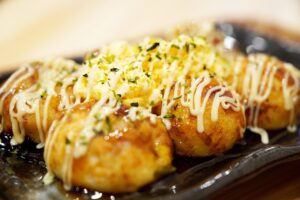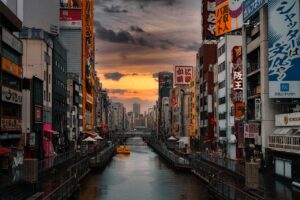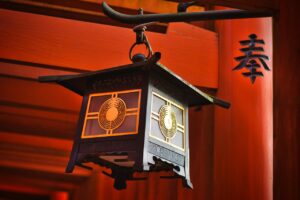Step off the polished, mainstream artery of Osaka’s Midosuji Boulevard, leave behind the glittering facades of high-fashion boutiques, and take a turn into a different dimension. You’ll feel it before you see it—a subtle shift in the city’s rhythm, a bass line thumping from a basement shop, the scent of sizzling takoyaki mingling with vintage leather and sweet crepe batter. You’ve just crossed the invisible threshold into Amerikamura, the vibrant, chaotic, and unapologetically expressive heart of Osaka’s youth culture. Known affectionately as “Amemura” by the locals, this compact grid of streets isn’t just a shopping district; it’s a living, breathing canvas where fashion, art, music, and identity collide in a spectacular display of creative freedom. For decades, it has served as the incubator for Japan’s most daring street styles and the spiritual home for anyone who marches to the beat of their own drum. It’s a place built on a foundation of rebellion, a celebration of the unconventional, where the city’s youth come not just to shop, but to see and be seen, to connect, and to express who they truly are. From the iconic miniature Statue of Liberty peering down from a rooftop to the riot of color splashed across building-sized murals, Amerikamura is a sensory overload in the best possible way—a raw, unfiltered look into the soul of urban Japan. It is, in essence, the cultural ground zero for everything cool, edgy, and innovative in Osaka.
After soaking in the vibrant street culture, you can continue your Osaka adventure by exploring the legendary street food scene in Dotonbori.
The Birth of a Counter-Culture Capital: A Brief History of Amemura

To fully grasp the spirit of Amerikamura, you need to rewind the clock to the late 1960s and early 1970s. At that time, this district, located west of the lively Shinsaibashi shopping arcade, was a quiet, modest area dominated by warehouses, parking lots, and traditional shops. It was hardly a place where you’d expect a cultural revolution to begin. Yet revolutions rarely ignite in the spotlight. They simmer in forgotten corners, driven by a new generation eager for change. The spark for Amemura’s transformation came from a small group of visionary young entrepreneurs who noticed a gap in the market and, more importantly, a cultural craving. While mainstream department stores sold uniform, mass-produced fashion, these pioneers looked across the Pacific for inspiration.
They traveled to the United States, especially the West Coast, returning with suitcases filled with treasures that were rare in Japan at that time: vintage Levi’s jeans, worn band t-shirts, Hawaiian shirts, surfboards, and vinyl records alive with the sounds of American rock and folk music. They began selling these items out of converted warehouses and small, makeshift shops. One of the earliest and most influential figures was a designer who opened a café and started selling imported goods, transforming a sleepy warehouse district into a bustling destination. The attraction was compelling. For Osaka’s youth, these items weren’t just clothes or products; they were symbols of a different lifestyle—a culture of freedom, individuality, and casual rebellion that sharply contrasted with the formal, structured society of post-war Japan. The name “Amerikamura,” or “American Village,” wasn’t an official city designation but rather an organic nickname that grew on the streets, reflecting the origin of the goods that shaped its emerging identity. The area became a refuge for those who didn’t fit into the neat categories of mainstream society. It was rough around the edges, unrefined, and thrillingly genuine. While the Shinsaibashi-suji shopping arcade nearby epitomized established consumerism, Amemura became its rebellious younger sibling, promoting a do-it-yourself spirit that continues to define it today.
A Symphony of Sights and Sounds: The Atmosphere of Amerikamura
Strolling through Amerikamura is an immersive experience that captivates all the senses. The atmosphere is a dynamic collage of movement, color, and sound, a location that feels eternally vibrant. The first thing that strikes you is the visual chaos. This is not a quarter defined by sleek, minimalist design; it’s an explosion of creativity. Almost every surface serves as a potential canvas. Building facades boast massive, colorful murals crafted by both local and international artists. Steel shutters, lowered after hours, display intricate graffiti art, turning practical security features into an expansive nighttime gallery. Even the streetlights join the spectacle, shaped into quirky, humanoid figures that appear to dance above the crowds, their metallic forms caught mid-stride or in playful poses. High above, a kitschy but cherished replica of the Statue of Liberty projects from a rooftop, a whimsical nod to the area’s namesake and a landmark for navigating the maze-like streets.
The soundtrack of Amemura is as diverse as its visuals. There isn’t a single tune but rather a blend of overlapping soundscapes. From the open doors of a vintage clothing store, the raw, distorted guitar of a 90s grunge band might spill into the street, mingling with the heavy bass and rapid-fire lyrics of Japanese hip-hop booming from a sneaker shop nearby. The steady clatter of skateboard wheels on concrete provides a constant rhythmic backdrop, a sound as integral to Amemura as the buzz of the crowds. Shop employees, often equipped with megaphones, call out to passersby, their voices adding to the lively, market-like atmosphere. It’s a place where you can feel the heartbeat of subculture in its purest form.
And then there’s the fashion—the true essence of Amerikamura. This is a real-life runway where the only rule is that there are no rules. It’s a living archive of subcultures. You’ll see young people clad head-to-toe in painstakingly curated vintage outfits from the 70s, their flared jeans and paisley shirts paying homage to a bygone era. Nearby, groups might sport avant-garde streetwear, featuring oversized silhouettes from obscure Japanese designers and limited-edition sneakers treated like priceless treasures. Punks with spiked leather jackets and torn jeans coexist alongside followers of gothic lolita fashion, their elaborate frills and lace sharply contrasting with the gritty urban setting. It’s a place where individuality is the highest currency. People don’t come here to follow trends—they come to set them. The vibe is one of acceptance and curiosity. It’s a space where you can wear your most extravagant outfit and receive approving nods instead of stares, a testament to its role as a sanctuary for self-expression.
The Canvas of the City: Street Art and Public Installations
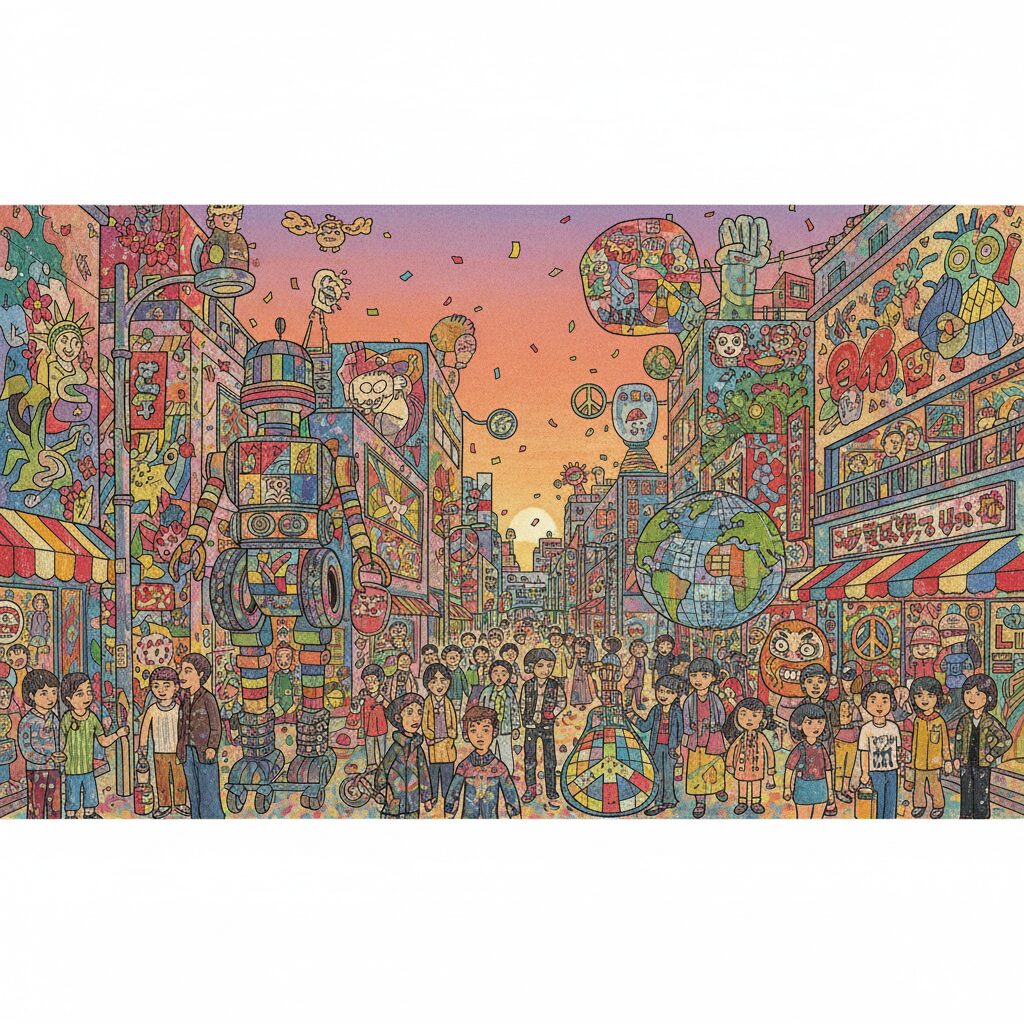
While fashion is its lifeblood, street art forms Amerikamura’s very skin. The district stands as arguably Osaka’s largest and most dynamic outdoor art gallery, a place where creativity bursts beyond the confines of four walls. The art here is never static; it is a living, evolving entity. A mural that dominates a wall one month might be replaced by a new masterpiece the next, embodying the transient and ever-changing spirit of street culture itself. This fleeting nature ensures that each visit offers a unique experience, capturing a specific moment in the area’s artistic timeline. The roots of this creative energy date back to the 1980s, when visionary artist Seitaro Kuroda was commissioned to adorn the buildings around Sankaku Koen, the district’s central hub. His large, vibrant works, including the renowned “Peace on Earth,” injected a surge of creative vitality into the area and established a standard for public art that endures today.
One of the most iconic examples of Amemura’s dedication to public art is the streetlights. Crafted by local artists, these are far from ordinary municipal lamps; each is a distinct sculpture. Some resemble abstract human figures with arms outstretched, as though welcoming visitors. Others take the form of robots, animals, or whimsical creatures, turning a simple stroll into a delightful treasure hunt. They serve as a constant reminder that in Amemura, even the most mundane infrastructure is a canvas for artistic expression. The art extends beyond large-scale murals and sculptures. Look closer, and you’ll discover a world of intricate detail. Lampposts and utility boxes are layered with stickers from countless artists, bands, and clothing brands—a practice called “sticker bombing” that creates a rich visual history of everyone who has passed through and left their mark. Even the ground beneath your feet becomes part of the canvas. Sankaku Koen, the central plaza, is a concrete expanse that functions as a stage, meeting place, and a masterpiece of urban design, its form and purpose deeply intertwined with the culture it embraces. Exploring Amerikamura becomes an exercise in looking up, down, and all around, as art is truly woven into the very fabric of the village.
A Shopper’s Paradise for the Unconventional Soul
Shopping in Amerikamura is an adventure, a world apart from the predictable atmosphere of a modern shopping mall. The district is a treasure trove for those in search of unique, one-of-a-kind items with stories to tell. Its specialty is “furugi,” the Japanese term for used or vintage clothing. The streets are lined with dozens of furugi shops, each showcasing its own carefully curated character. Some focus on classic American workwear, their racks filled with denim jackets, flannel shirts, and leather boots. Others highlight flamboyant styles from the 80s and 90s, featuring a vibrant array of neon windbreakers, graphic t-shirts, and bold patterns. Sifting through the racks of an Amemura vintage store is a rite of passage— a treasure hunt where you might uncover a rare band t-shirt, a perfectly worn leather jacket, or a designer piece from a past season at a fraction of its original cost. The quality is often exceptional, reflecting Japanese consumers’ deep appreciation for well-crafted goods and the concept of “mottainai”—a cultural aversion to waste.
Beyond vintage, Amerikamura is a haven for independent designers and small boutiques. Many of these shops occupy upper floors of unassuming buildings, their presence marked only by a small sign at street level. It’s worth being adventurous and exploring these hidden spaces. Inside, you’ll find clothing, accessories, and art from local Osaka designers pushing the boundaries of fashion. These aren’t mass-market items; they are limited-run creations born from genuine passion and creativity. This is where you discover the next big trend before it hits the mainstream. The area is also a key hub for streetwear and sneaker culture. Enthusiasts from across Kansai gather at its specialty stores seeking the latest drops from brands like Supreme and A Bathing Ape, as well as rare and collectible sneakers. The staff in these shops are often collectors themselves, with encyclopedic knowledge and infectious passion.
But the shopping experience extends beyond clothing. Amerikamura also hosts a remarkable collection of independent record stores, their crates brimming with vinyl spanning every imaginable genre. Music lovers can easily lose hours flipping through records, uncovering obscure Japanese jazz artists, classic punk albums, and the newest electronic releases. Countless “zakka” shops, covering everything from quirky stationery and handmade accessories to quirky toys and pop culture memorabilia, are scattered throughout the area. A helpful tip for first-time visitors: always look up. The ground floor is just the beginning. Some of the most interesting and unique shops are tucked away on the second, third, or even fourth floors. Don’t hesitate to enter a building that looks like an office block—you might just find your new favorite store inside.
Fueling the Rebellion: The Flavors of Amemura
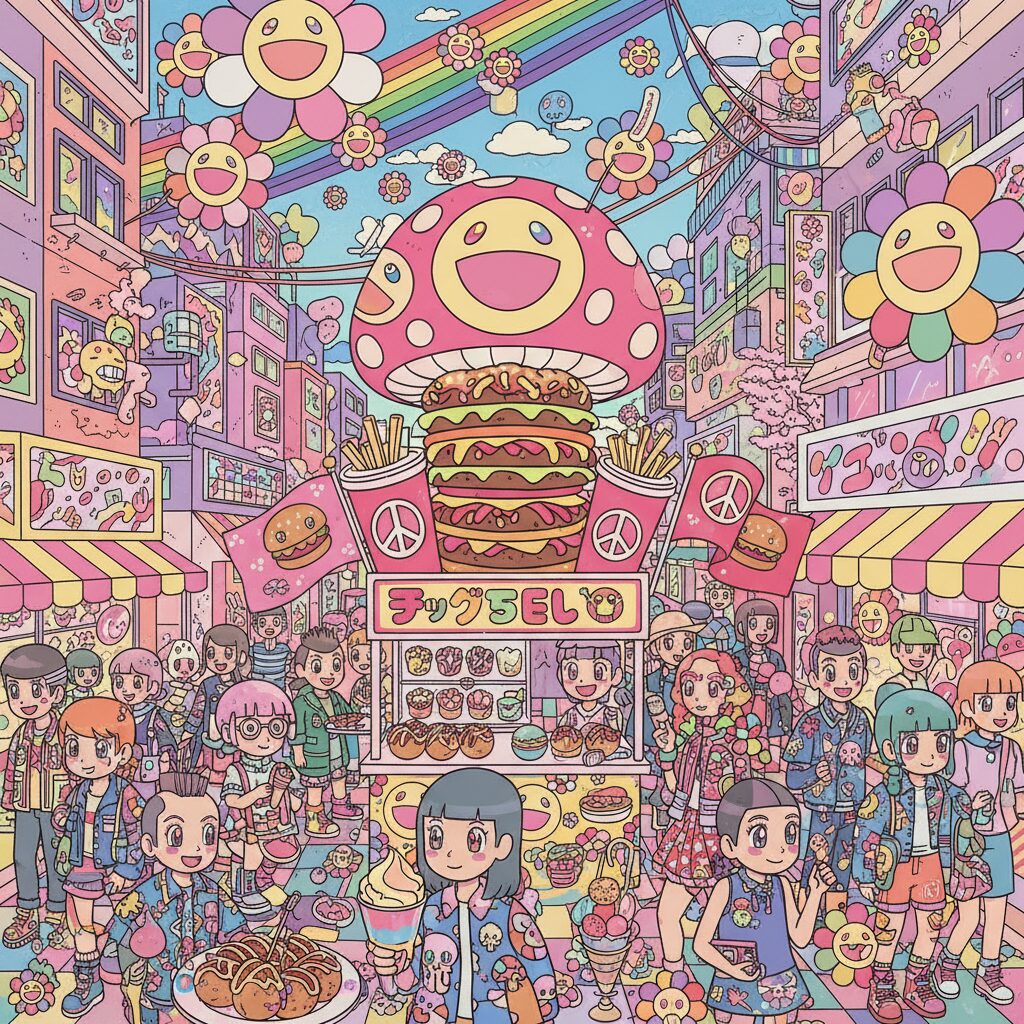
The creative energy of Amerikamura spills over into its food scene, which is just as eclectic, unpretentious, and youth-focused as its fashion. This isn’t a place for formal, multi-course dining. Instead, the culinary landscape is dominated by street food and casual eateries designed for enjoying on the go, allowing you to refuel without slowing down. The undisputed king of Amemura street food is takoyaki. While this beloved Osaka specialty—diced octopus cooked in a savory batter and shaped into balls—can be found throughout the city, the stalls in and around Amemura are legendary. They serve the classic version slathered in a sweet and savory brown sauce, drizzled with Japanese mayonnaise, and topped with bonito flakes and seaweed powder. At the same time, they get creative with inventive variations featuring toppings like cheese, spicy cod roe, or green onions with sharp ponzu sauce. Watching the vendors expertly flip the dough balls in their special cast-iron pans is a captivating piece of culinary theater.
Another iconic and highly Instagrammable Amemura treat is the “Long Soft Cream.” As the name suggests, this is a soft-serve ice cream cone stretched to a comical, gravity-defying length, often exceeding 30 centimeters. It’s a playful, whimsical snack that perfectly embodies the area’s fun spirit. Beyond these two favorites, the streets offer a variety of tempting options. Vendors sell karaage (Japanese fried chicken) in paper cups, sweet and savory crepes filled with everything from strawberries and cream to tuna and cheese, and a multitude of bubble tea shops featuring endless flavor and topping combinations. This emphasis on portable, affordable, and delicious food fits the area’s demographic of students and young creatives who prioritize socializing and exploring over lengthy sit-down meals.
When you do want to sit and unwind, Amemura provides a range of unique cafes and bars as distinctive as its shops. Generic coffee chains are scarce here. Instead, you’ll find small, independently owned cafés with quirky décor, basement bars that double as art galleries, and intimate “live houses” where you can enjoy performances by emerging local bands. These venues often serve as social hubs, where friendships form, collaborations develop, and the creative spirit of Amerikamura thrives over a cup of coffee or a cold beer. Dining in Amemura is not just about nourishment; it’s a vital part of the cultural experience.
The Heartbeat of Amemura: Sankaku Koen (Triangle Park)
At the very center of Amerikamura beats its heart and soul: Sankaku Koen, or Triangle Park. Calling it a “park” is somewhat misleading, as there isn’t a single blade of grass in sight. Instead, it is a concrete plaza shaped like a triangle, encircled by steps that double as seating. Despite its modest appearance, this public space stands as the most significant landmark of the district. It serves as Amemura’s communal living room, the stage where daily life unfolds. From morning until late at night, Sankaku Koen buzzes with activity. It’s the spot where friends meet before a day of shopping, where skaters refine their kickflips and grinds, their boards’ echoes filling the plaza. It’s where aspiring musicians strum guitars, dance crews rehearse their newest routines, and street performers entertain small crowds with magic tricks or comedic acts.
This is where Amemura’s fashion truly takes center stage. People don’t just pass through Sankaku Koen; they stay, observe others, and display their own distinctive styles. Sitting on the park’s steps feels like having a front-row seat to Japan’s most dynamic fashion show. The space is meant for seeing and being seen—a live gallery of street style in all its vibrant diversity. Occasionally, the park hosts events like flea markets, live concerts, and public art installations. It’s a versatile, democratic space that shifts to meet the community’s needs. Adjacent to the park stands one of Osaka’s most famous takoyaki vendors, with a long line of customers that’s a constant sight. Grabbing a boat of freshly made takoyaki and finding a spot on the steps of Sankaku Koen is a quintessential Amemura experience. In these simple moments—sharing food, watching the world go by, and soaking up the creative energy—you can truly sense the neighborhood’s pulse. Sankaku Koen is more than just a physical place; it embodies the community, freedom, and spontaneous creativity that define Amerikamura.
Practical Guide for the Urban Explorer
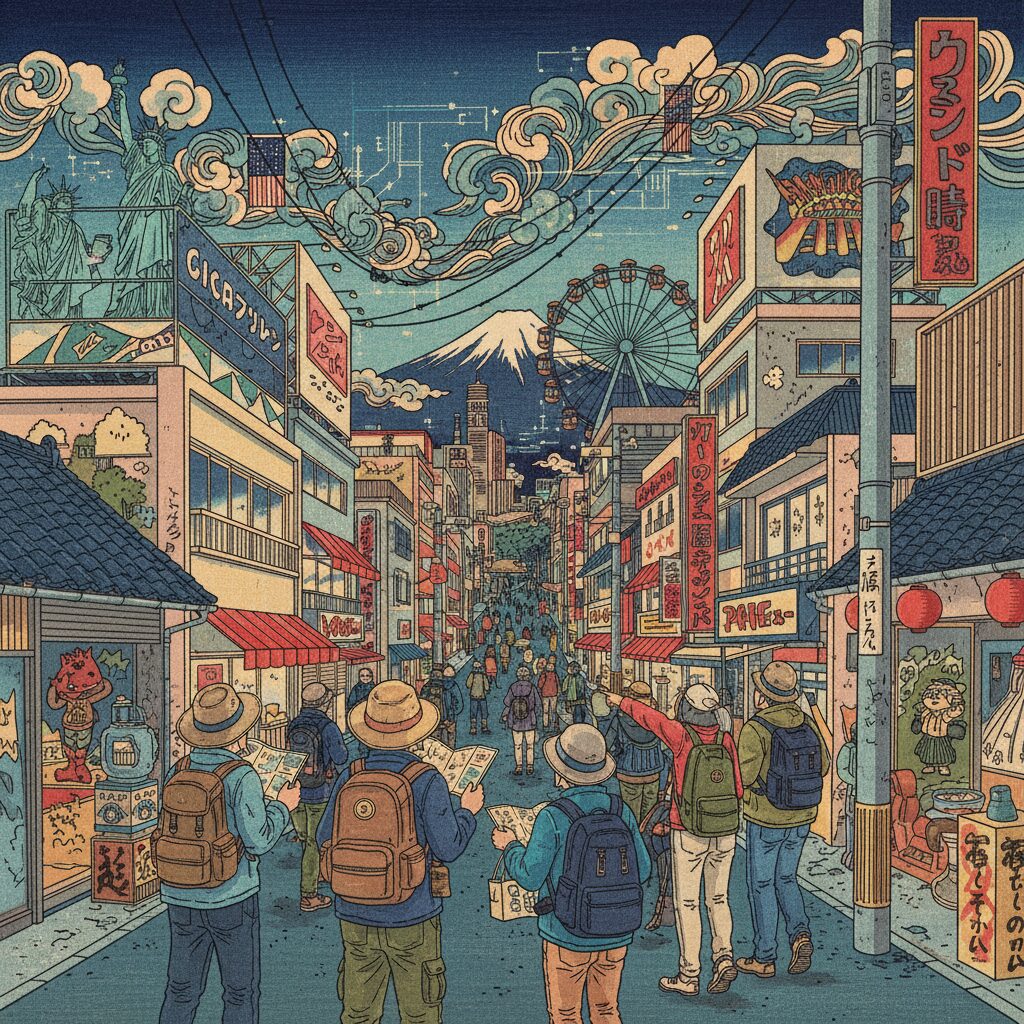
Navigating Amerikamura is fairly simple, but a few tips can enhance your visit. Its location is extremely convenient, situated just west of the main Shinsaibashi-suji shopping arcade. The easiest way to reach it is by subway: take the Midosuji Line to Shinsaibashi Station or the Yotsubashi Line to Yotsubashi Station. From either station, it’s only a five-minute walk. If you’re near the famous Glico Running Man sign in Dotonbori, Amerikamura is about a ten-minute walk away, making it easy to visit these iconic Osaka spots in one trip.
The ideal time to experience Amerikamura is from late afternoon into the evening. While shops are open during the day, the district truly comes alive around 3 or 4 PM when students finish classes and the streets start filling up. As dusk sets in, the neon signs illuminate, music grows louder, and the atmosphere becomes electric. Weekends are the liveliest and most crowded, offering great opportunities for people-watching. For a quieter shopping experience, weekday afternoons are a better option.
Once you arrive, the best approach is to simply wander. Amerikamura is a compact grid, so it’s hard to get truly lost. While the main street can be busy, the charm often lies in the narrow side streets and alleys. Don’t hesitate to explore off the beaten path. Staircases leading up or down often reveal hidden gems. Although many larger stores accept credit cards, it’s wise to carry some cash since smaller vintage shops, independent boutiques, and street food vendors may only take cash. Lastly, come with an open mind. You’ll encounter styles and subcultures you might never have seen before. Embrace the diversity and creativity. Talk with shopkeepers, many of whom are passionate about their craft and can offer fascinating insights into the culture behind their items. Amerikamura rewards curiosity—the more you explore, the more you’ll find.
Amerikamura Today: Evolving but Forever Rebellious
Like any dynamic cultural hub, Amerikamura is far from static. It has transformed considerably since its early days as a rough outpost for imported American goods. The advent of the internet and social media has drawn global attention to its distinctive street style, attracting more international visitors and shaping trends well beyond Osaka. While some of its original roughness has softened and a few larger chain stores have entered the area, to suggest that Amemura has lost its essence would be a serious misinterpretation of its resilient character. The heart of Amerikamura remains boldly intact. It is still, above all, a space for subculture rather than mainstream culture. It continues to serve as a platform for independent artists, musicians, and designers. The DIY spirit that sparked its beginning is still visible in the owner-run shops and the ever-evolving street art.
What makes Amerikamura so crucial to Osaka’s identity is its role as a cultural counterpart to the city’s other neighborhoods. If Umeda represents Osaka’s sleek, corporate side, and Namba and Dotonbori embody its loud, food-centric entertainment hub, then Amerikamura is its rebellious, creative heart. Here, commercialism takes a backseat to self-expression, and individuality is revered above all else. It has successfully absorbed new influences without losing its distinctiveness, blending global streetwear trends while still promoting its own unique vintage and alternative cultures. This ongoing state of evolution is what keeps it vibrant. Amerikamura is not a museum of past youth movements; it is a living workshop where the future of Japanese street culture is being actively shaped every day.
An Invitation to the Organized Chaos
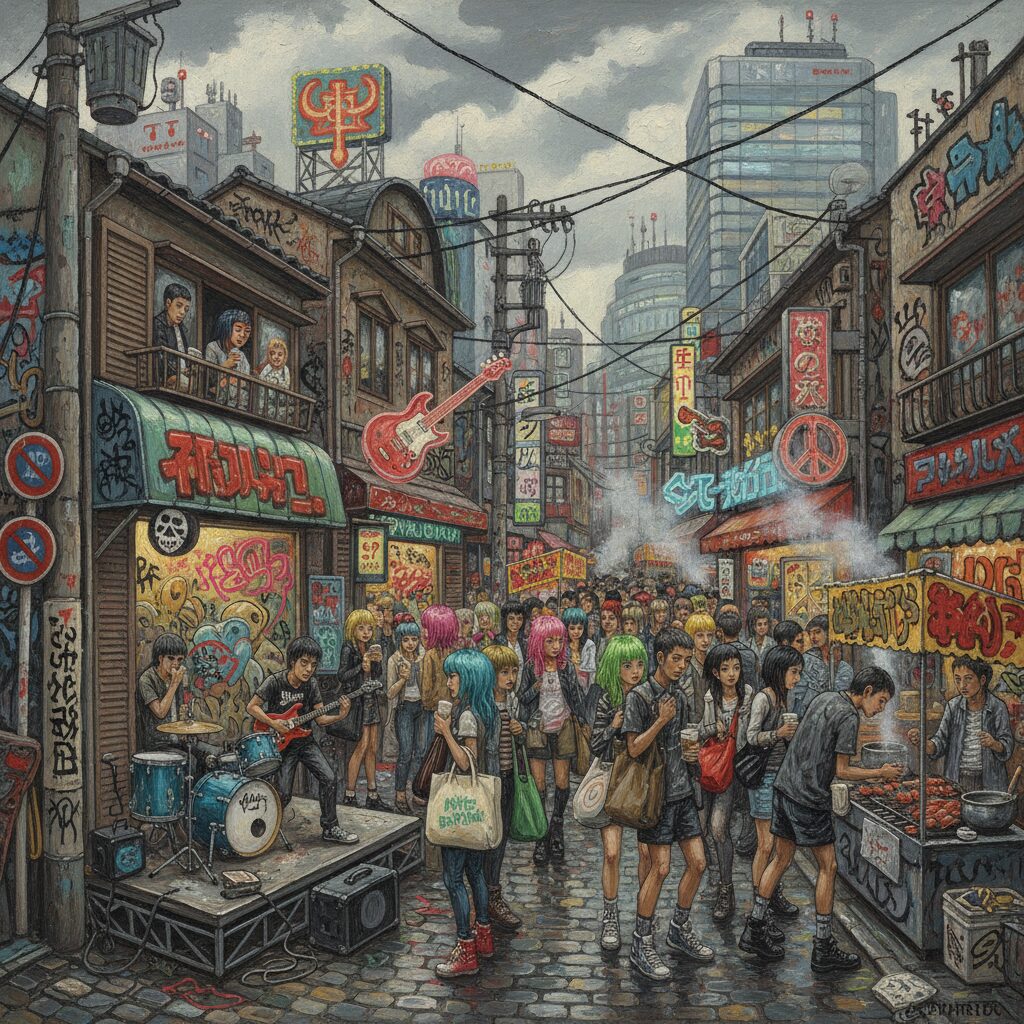
Amerikamura is more than just a point on a map; it embodies a state of mind. It stands as a vibrant tribute to the energy of youth, creativity, and the bravery to stand out. Visiting Amemura means immersing yourself in an atmosphere of pure, unfiltered self-expression. It’s a place to explore without a fixed plan, allowing your senses to lead you through streets adorned with art, to find a piece of clothing that seems tailor-made for you, and to savor the simple, delightful tastes of Osaka’s street food. It serves as a reminder that the most thrilling culture often emerges not in pristine galleries or concert halls, but on sidewalks, in basements, and within the small, passionate communities nestled in a city’s overlooked corners. So, when you visit Osaka, step off the main path and dive into the vibrant, organized chaos of Amerikamura—you might just discover a part of yourself you never knew existed.




